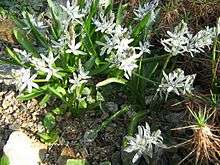Fessia
Fessia is a genus of bulbous flowering plants in the family Asparagaceae, subfamily Scilloideae (also treated as the family Hyacinthaceae).[2] It is distributed from Iran to Central Asia and Pakistan.[1]
| Fessia | |
|---|---|
 | |
| Fessia puschkinioides in cultivation at the Berne Botanical Gardens | |
| Scientific classification | |
| Kingdom: | Plantae |
| Clade: | Tracheophytes |
| Clade: | Angiosperms |
| Clade: | Monocots |
| Order: | Asparagales |
| Family: | Asparagaceae |
| Subfamily: | Scilloideae |
| Genus: | Fessia Speta[1] |
Description
Species of Fessia grow from bulbs, which are covered by a gray or black tunic, purple inside. Each bulb produces one or more flower stems (scapes) bearing whitish to blue or violet flowers. The stamens have pale blue anthers. The black seeds are globe or drop shaped.[3]
A number of species of Fessia, often under their earlier names in the genus Scilla, are grown by gardeners specializing in ornamental bulbous plants; they are hardy but some need a dry period in summer. F. puschkinioides (syn. Scilla puchkinioides) is described as "an easy to grow hardy species".[4]
Systematics
The genus Fessia was created by Franz Speta in 1998. All the species were previously included in a more broadly defined genus Scilla.[5] The genus is placed in the tribe Hyacintheae (or the subfamily Hyacinthoideae by those who use the family Hyacinthaceae).[6]
Species
As of March 2013, the World Checklist of Selected Plant Families recognized 11 species:[5]
- Fessia bisotunensis (Speta) Speta
- Fessia furseorum (Meikle) Speta
- Fessia gorganica (Speta) Speta
- Fessia greilhuberi (Speta) Speta
- Fessia hohenackeri (Fisch. & C.A.Mey.) Speta
- Fessia khorassanica (Meikle) Speta
- Fessia parwanica (Speta) Speta
- Fessia purpurea (Griff.) Speta
- Fessia puschkinioides (Regel) Speta
- Fessia raewskiana (Regel) Speta
- Fessia vvedenskyi (Pazij) Speta
References
- "Fessia", World Checklist of Selected Plant Families, Royal Botanic Gardens, Kew, retrieved 2013-04-02
- Stevens, P.F. (2001 onwards), "Asparagales: Scilloideae", Angiosperm Phylogeny Website, retrieved 2013-04-02
- "Fessia Speta", eMonocot, archived from the original on 2013-04-19, retrieved 2013-04-02
- Mathew, Brian (1987), The Smaller Bulbs, London: B.T. Batsford, ISBN 978-0-7134-4922-8, pp. 152–153, 156
- Search for "Fessia", World Checklist of Selected Plant Families, Royal Botanic Gardens, Kew, retrieved 2013-04-02
- Pfosser, Martin; Speta, Franz (1999). "Phylogenetics of Hyacinthaceae based on plastid DNA sequences" (PDF). Annals of the Missouri Botanical Garden. 86 (4): 852–875. doi:10.2307/2666172. JSTOR 2666172.
| Wikimedia Commons has media related to Fessia. |